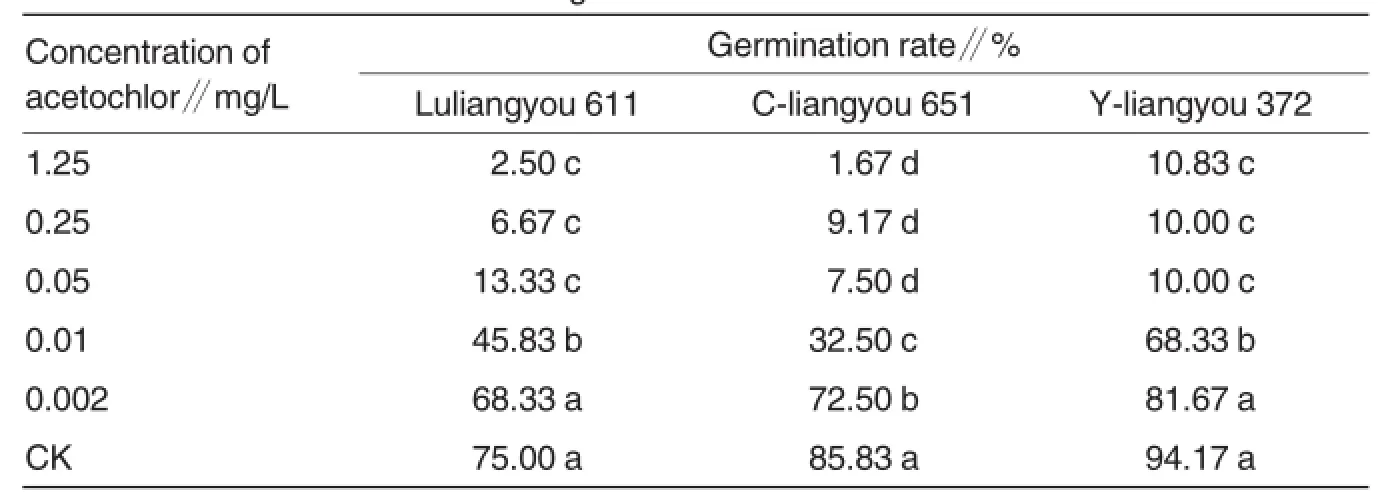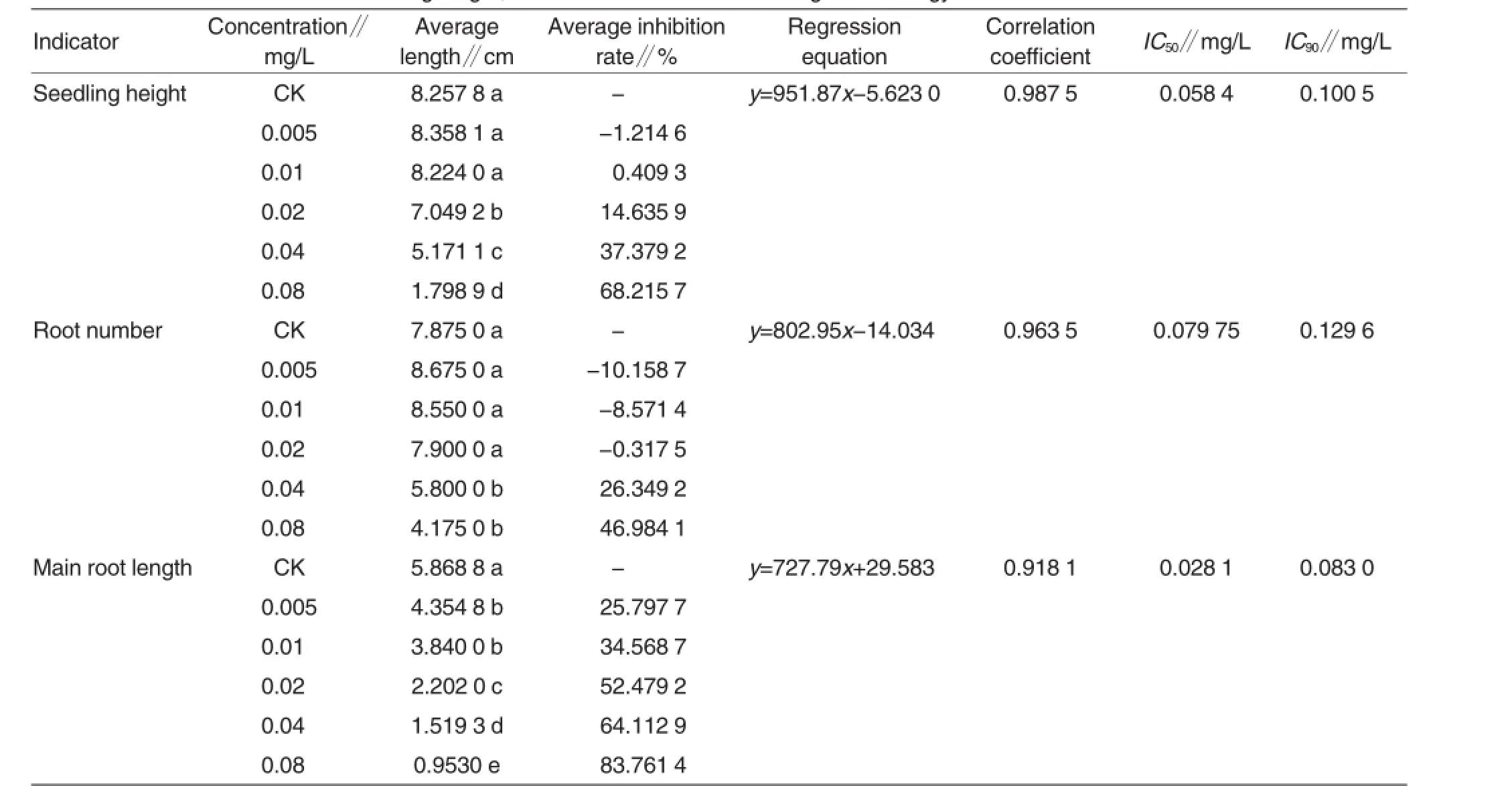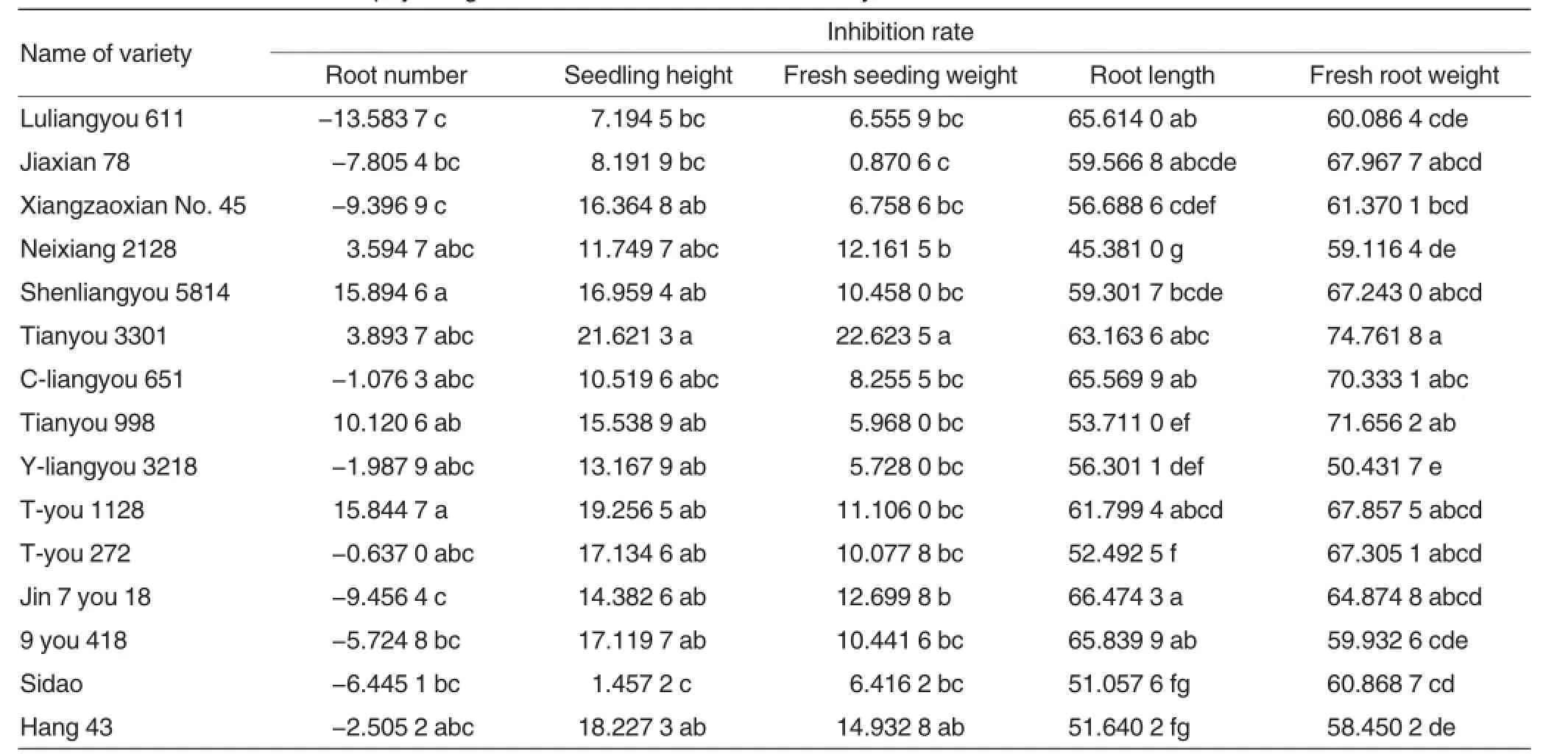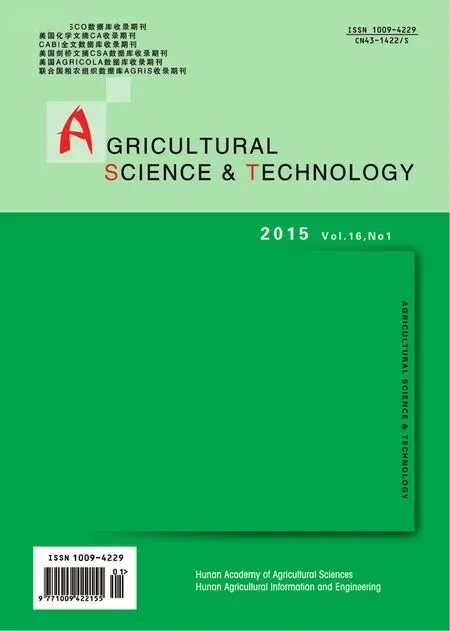Study on Sensitivities of16 Rice Varieties to Acetochlor
Xianglin LIU,Lianyang BAI,2,3,Chenzhong JIN,2*,Jingbo LI,2,Yanan DENG,Qinyan LIU
1.College of Agriculture and Biotechnology,Hunan University of Humanities,Science and Technology,Loudi 417000,China;
2.Collaborative Innovation Center for Farmland Weeds Control,Hunan University of Humanities,Science and Technology,Loudi 417000,China;
3.Hunan Academy of Agricultural Sciences,Changsha 410128,China
Study on Sensitivities of16 Rice Varieties to Acetochlor
Xianglin LIU1,Lianyang BAI1,2,3,Chenzhong JIN1,2*,Jingbo LI1,2,Yanan DENG1,Qinyan LIU1
1.College of Agriculture and Biotechnology,Hunan University of Humanities,Science and Technology,Loudi 417000,China;
2.Collaborative Innovation Center for Farmland Weeds Control,Hunan University of Humanities,Science and Technology,Loudi 417000,China;
3.Hunan Academy of Agricultural Sciences,Changsha 410128,China
In this study,the effects of acetochlor on the growth of 16 rice varieties were investigated.In addition,the sensitivity of different rice variety to acetochlor and the relationship between sensitivity and variety type were also studied.The effects of acetochlor on the germination of rice were determined in Petri dishes.The inhibitory effects of acetochlor on the seedling height,root length,seedling weight, root weight and other indicators of rice varieties were determined by agar method. The result showed the acetochlor had a certain inhibitory effect on the germination of rice.The low-concentration acetochlor would increase the seedling height and root number.However,when the concentration of acetochlor reached a certain value,its inhibitory effects became obvious.The inhibitory effect of acetochlor on rice roots was stronger than that on rice stems.Among the rice varieties,Sidao had the highest acetochlor tolerance,and Tianyou 3301 had the highest sensitivity to acetochlor.The average inhibition rates of seedling height,fresh seeding weight,root length,fresh plant weight and root number of Sidao in agar culture medium with 0.02 mg/L of acetochlor were 1.46%,6.42%,51.06%,60.87%and-6.45%,respectively,while of Tianyou 3301 were 21.62%,22.62%,63.16%,74.76%and 3.89%, respectively.The sensitivity to acetochlor differed significantly among different rice variety.However,this difference had no significant relationship with variety type.
Rice;Acetochlor;Sensitivity
A cetochlor belongs to chloroacetyl-class selective preemergence herbicides.It inhibits cell growth mainly through impeding protein synthesis,thereby stopping the growth of and even killing the plumule and radicel of weeds[1].Acetochlor is mainly used in corn,cotton, soybean,rapeseed and other dryland crops for controlling annual grass weeds and some broadleaf weeds.It is characterized by high activity,long period of validity,broad spectrum and small consumption.Acetochlor is one of the top 3 herbicides in yield and demand in current Chinese market[2].In recent years,the acetochlor and its compounding agents have started to be applied in rice fields and seedbeds. Since the rice seedlings are very sensitive to acetochlor,the application range of acetochlor in rice fields is more limited[3-5].
Landi et al.[6]and Hoffman et al.[7]found the sensitivity of corn to acetochlor and its compounding agents differed significantly among different lines;the tolerance of corn to acetochlor is dominantly inherited;selective breeding of acetochlor-tolerant crop varieties was considered to be an important measure to reduce or eliminate the toxic effect of acetochlor on crops.The researches ofHayes etal.[8]showed the difference in tolerance and sensitivity to acetochlor is mainly caused by the difference in metabolic rate of herbicides and genetic system thatis responsible for metabolizing the secondary metabolites,representedby herbicides,among different soybean variety.Ran et al.[9-10]and Hu et al.[5]found the sensitivity of rice has no relationship withα-amylase,but the activity of glutathione-S-transferase is closely related to the acetochlor tolerance of rice.They also found the sensitivity of rice to acetochlor differed among different variety,which was considered to be caused,at the physiology level,by the inhibited respiratory peak during the germination.
The toxic effect of herbicides seriously affects China’s grain production[11].Since rice is very sensitive to acetochlor,the injuries are prone to be produced.The injuries,caused by burachlor also continue to occur due to the existence of impurities,including acetochlor and alachlor[12-13].The utilization of acetochlor will reduce the costs of herbicides for rice fields. However,with the broadened utilization range and increased utilization amount ofacetochlor in rice fields,the injuries,caused by acetochlor are the major part of injuries that occur in rice fields[14].The determination of sensitivity of different rice variety to acetochlor,the screening of acetochlor tolerantand sensitive varieties and the analysis on difference in physiological metabolism and genetic system of different types of rice varieties at the cell and molecular level will help to further clarify the related mechanism of difference in acetochlor tolerance among different rice varieties.The existed researches on the sensitivity of rice to acetochlor all have small sample size. Moreover,they do notexplore the related mechanisms from the perspective ofgeneric influence.
In this study,based on the research on the effects of acetochlor on the rice germination and on the effects of different-concentration acetochlor on the growth of rice,we determined the sensitivities of16 rice varieties to the same-concentration acetochlor by agar method to investigate the sensitivity of different rice variety to acetochlor and the relationship between sensitivity and variety type. This willprovide a theoreticalbasis for the broadening of acetochlor utilization range in rice fields and the selective breeding of acetochlor tolerant rice varieties.
Materialand Methods
Material
Test reagentsThe trade name of the 50%acetochlor EC was Nongdeyi, and it was purchased from the Green Land ChemicalCo.,Ltd.
Rice varieties
The rice varieties included Luliangyou 611(Indica hybrid early rice),Neixiang 2128,Shenliangyou 5814,Tianyou 3301,C-liangyou 651(Indica hybrid middle rice),Tianyou 998,Y-liangyou 3218,T you 1128,T you 272,Y-liangyou 372 (Indica hybrid late rice),Jin 7 you 18,9 you 418(Japonica hybrid rice),Jiaxian 78,Xiangzaoxian No.45(conventional Indica rice),Sidao and Hang 43(Conventional Japonica rice).The rice seeds were provided by the Hunan Yahua Seed Co.and the Loudi Institute ofAgriculturalScience.
Methods
Determination of effects of acetochlor on rice germination in Petri dishes
The 50%acetochlor EC was used to prepare the mother liquor with 0.125 g/L of acetochlor.Then a series of solutions with gradient concentrations(1.25,0.25,0.05,0.01,0.002 mg/L)of acetochlor were prepared. After soaked,the good-quality seeds were picked outand then placed on 2-layer filter paper in Petri dishes.The filter paper was previously moistened with different-concentration acetochlor solutions.There were 30 seeds in each Petri dish.Each treatment was duplicated 4 times.The water control was arranged.Then the seeds were incubated in the artificialclimate incubator(26℃;6 000 lx for24 h,14 h;darkness,10 h).The germinated number was counted 3 d later for calculating the germination rate.
Determination of effects of acetochlor on physiological indicators of rice by agar methodThe sameamount of boiled 3%agar solution (200 ml)was added in each beaker (500 ml)and cooled.The 50%acetochlor EC was used to prepare the mother liquor with 0.320 g/L of acetochlor.Then a series of solutions with gradientconcentrations(3.2,1.6,0.8, 0.4,0.2 mg/L)of acetochlor were prepared.When the temperature of agar culture medium declined to 35℃(before solidification),5 ml of each concentration of acetochlor solution was added to the agar culture medium.And then the agar culture media with gradient concentrations(0.08, 0.04,0.02,0.01,0.005 mg/L)of acetochlor were prepared.There were 3 duplications for each treatment.The water control was arranged.Then the rice seeds with 0.5 cm of buds were put into the solidified agar culture media(12 seeds/beaker).After sealed with thin film,the beakers were placed in the artificialclimate incubator(28℃, 6 000 lx,12 h;25℃,darkness,12 h; humidity,85%).The seeds were incubated for 10 d.After then,8 seedlings were selected randomly for each treatment for the measurement of seedling height,fresh plant weight,root length, fresh root weight and root number. The inhibition rate and IC50of each indicator were calculated.
Determination of sensitivity of differentrice variety by agar method
Under the same concentration of acetochlor,the effects of acetochlor on seedling height,fresh plant weight, main rootlength,fresh root weight and root number of rice were determined (test program was as above).The covered rice varieties included Indica hybrid rice,Japonica hybrid rice and conventional rice.Thus the relationship between the sensitivity ofdifferentrice variety to acetochlor and the variety type was studied.
The data analysis was completed by using the Duncan’s multiple comparison of SPSS 19.0.
Results and Analysis
Effects of acetochlor on germination rate of rice
As shown in Table 1,when the acetochlor concentration ranged from 0.002 to 1.25 mg/L,the germination rates of the 3 rice varieties alldeclined with the increase of concentration. There were significant differences(P<0.05)in germination rate among treatments.Itwas indicated the acetochlor had strong inhibiting effects on the germination ofrice seeds.
Effects of different-concentration acetochlor treatments on the growth of rice
Table 2 showed the lowest concentrations of acetochlor,under which the root length,seedling height and root number differed significantly be-tween treatment and control groups were 0.005,0.02 and 0.04 mg/L,respectively.When the acetochlor concentration was 0.005 mg/L,the seedling heightoftreatmentgroup was largerthan thatofcontrolgroup.When the acetochlor concentration was 0.02 mg/L,the root number of treatment group was larger than that of control group.Combing the results above,it could be concluded the low-concentration acetochlor had a certain promoting effect on seedling height and root number of rice.The IC50of main root length,seedling height and root number were 0.028 1,0.058 4 and 0.079 8 mg/L,indicating the inhibiting effectofacetochloron main rootlength was stronger.The inhibition rates of seedling height,rootnumber and main rootlength allrose with the increase of acetochlor concentration.Therefore, the indicators about rice roots and seedlings can be treated as the bioassay parameter indexes for determining the sensitivity ofdifferentrice variety to acetochlor.

Table 1 Effects of acetochlor on rice germination
Sensitivity of different rice variety under different-concentration acetochlor treatment
As the analysis on experimental results above showed,when the concentration of acetochlor was lower than 0.01 mg/L,the effect of acetochlor on seedling height of rice was relatively small,and there was no significant difference between treatment and controlgroups;when the concentration of acetochlor reached 0.02 mg/L,the difference between the treatment and control groups reached the significant level,and the inhibition rate of seedling height was 14.64%; when the concentration of acetochlor reached 0.04 mg/L,the inhibition rate of seedling heightreached 37.38%.To avoid the insignificant differences in physiologicalindicators caused by too low or too high concentration of acetochlor,the germinated rice seeds of different variety were incubated in the agar culture media with acetochlor concentration of 0.02 mg/L.And thus the sensitivity ofdifferentrice variety to acetochlor and the relationship between sensitivity and variety type were investigated.
Difference analysis of sensitivity of different rice variety to acetochlor
As the statistical results showed the overall significances of differences in inhibition rates of root number, seedling height,fresh seedling weight, root length and fresh root weight among different rice varieties were 0.016,0.034,0.020,0.000 and 0.005, respectively.Under experimental concentrations,the differences in sensitivity of root number(P<0.05),seedling height(P<0.05),fresh seedling weight (P<0.05),root length(P<0.01)and fresh root weight(P<0.01)to acetochlor allreached the significant level among different rice varieties.Under the same-concentration acetochlor, variety had a relatively strong effect onthe indication rates of measured indicators,especially of root length and fresh root weight.It was also suggested there is a significant difference in sensitivity of different rice variety to acetochlor.

Table 2 Effects ofacetochlor on seeding height,root number and main root length of Y-liangyou 372

Table 3 Effects of acetochlor on physiological indicators of differentrice variety %
Among the rice varieties,the root number of Luliangyou 661,the seedling height of Sidao,the fresh seedling weight of Jiaxian 78,the root length of Neixiang 2128 and the fresh root weight of Y-liangyou 3218 had the lowest inhibition rates(-13.58%, 1.46%,0.87%,45.38%,50.43%).While the root number of Shenliangyou 5814,the seedling height of Tianyou 3301,the fresh seedling weight of Tianyou 3301,the root length of Jin 7 you 8 and the fresh root weight of Tianyou 3301 had the highest inhibition rates(15.89%,21.62%,22.62%, 66.47%,74.76%).For each indicator, the difference between the highestand lowest inhibition rates all reached the significantlevel.Under the experimental concentrations,the acetochlor had a rooting-promoting effect on 9 out of the 15 rice varieties.The comprehensive analysis showed Tianyou 3301 and T you 1128 were sensitive to acetochlor,while Sidao and Neixiang 2128 were tolerantto acetochlor.
Cluster analysis of sensitivity of different rice variety to acetochlorThe cluster analysis on the relationship between sensitivity and variety type was conducted.The analysis results showed:(1)the inhibition rate of root length of Indica rice was lower than thatof Japonica rice.(2)The inhibition rates of root length and fresh root weight ofconventional Indica rice were allhigher than those of Japonica rice,but the inhibition rate of root number was lower than that of Japonica rice.(3)The inhibition rates of seeding height and root number of early hybrid Indica rice were alllower than those of middle and late rice;the inhibition rate of fresh seedling weight of early hybrid Indica rice was lower than that of middle rice;the inhibition rate ofrootlength ofearly hybrid Indica rice was higher than thatofmiddle and late rice.However,the differences above among the early,middle and late hybrid Indica rice were allinsignificant.(4)The inhibition rates of allindicators showed no significant differences between hybrid and conventionalIndica rice.(5)The inhibition rate of rootlength of hybrid Japonica rice was higher than that of conventional Japonica rice(P<0.05).Therefore,except that the inhibition of root length of Japonica rice was affected by variety type,the inhibition of allother indictors of Japonica rice and of allindicators of Indica rice showed no significantrelationship with variety type.
Conclusions and Discussion
In Petri dishes,when the acetochlor concentration ranged from 0.002 to 1.25 mg/L,the germination rates differed significantly among Luliangyou 611,C-liangyou 651 and Y-liangyou 372.It is indicated the acetochlor had a strong inhibition effect on the germination of rice seeds,which is consistent with the results of Huang et al[15].In addition,the effects of acetochlor on rice germination differed among different variety.In agar culture media,when the acetochlor concentration ranged from 0.005 to 0.08 mg/L,the IC50s of seedling height and root length of Y-liangyou 372 were 0.058 4 and 0.028 1 mg/L respectively,indicating the inhibition effect of acetochlor on roots was stronger than thaton stems.This conclusion was consistent with that of the research on the sensitivity of rice to ethametsulfuron.When the acetochlor concentration was 0.005 mg/L,the inhibition rates of root number and seedling height were-1.21%and -10.16%respectively.It is indicated the 0.005 mg/L of acetochlor has certain promoting effects on the growth of rice.In a previous study,the low-concentration(<8 mg/L)acetochlor has been proved to have growth-promoting effects on nitrogen-fixing Anabaena.
When the acetochlor concentration was 0.02 mg/L,the overallsignificances ofdifferences in inhibition rates of root number,seedling height,fresh seedling weight,root length and freshroot weight among different rice varieties were 0.016,0.034,0.020,0.000 and 0.005,respectively,indicating the presence of significant difference in sensitivity of different rice variety to acetochlor.
Low-concentration acetochlor treatment can promote the rooting of most rice varieties.However,under our experimental concentrations,the acetochlor all inhibited the root length of different rice variety.Whether a lower concentration of acetochlor will promote the root length of rice and whether the promoted rooting will improve the lodging resistance of rice, enhance the absorption of nutrients and supplement the growth of rice at late growth period all need to be studied further.
At present,the difference in sensitivity of different corn and soybean varieties to acetochlor has been considered to be related to the relevant genetic system[6,8].If this hypothesis is adapted to rice,the anti-herbicide genetic engineering and pollen tube channeltechnology can be used to improve the sensitivity of rice to acetochlor.The resistance gene can be inserted into the genome of rice to achieve the genetic recombination[18]. Thus the acetochlor-tolerance rice varieties can be bred rapidly.The researches on the plant security agents have made a great progress[19-20].The plant security agents have a good environmentalcompatibility,and they will not bring environmentalproblems.The application of security agents willprovide a theoretical basis and technical support for prolonging the period of validity and enlarging the utilization rang ofacetochlor in rice fields.
To our knowledge,this is the first time to discuss the relationship between the sensitivity of rice to acetochlor and variety type.A systematic analysis is conducted on the sensitivities of several broadly-promoted rice varieties to acetochlor.The relatively high tolerant varieties are screened out.This will provide a theoretical basis forthe selective planting ofrice varieties and the breeding oftolerantvarieties.However,in our study,some of the rice varieties only have a small sample size.Therefore,part of the conclusions above still needs to be verified further.
[1]ZHAO DY(赵德友).Harms ofacetochlor to corn(乙草胺对Ⅰ米药害的研究)[D]. Beijing:China Agricultural University(北京:中国农业大学),2005.
[2]DUAN YS(段又生).Inventory on Chinese herbicide products marketin 2012 (2012年中国农药大宗产品市场盘点) [J].China AgriculturalMeans of Production(中国农资),2013,28(1):24.
[3]QIU YQ(丘银清),HOU RZ(候任昭), JIANG RL(江如蓝).Comparative study on resistance of rice against butachlor and acetochlor(水稻对丁草胺和乙草胺抗性的比较研究)[J].Journal of South China Normal University(Natural Sciences)(华南师范大学学报(自然科学版)),2001,4:79-83.
[4]YE H(叶蕙),LIU W(刘伟),CHEN JX(陈建勋).Harms of acetochlor to rice and protective effect of acetochlor on harms (乙草胺对水稻的伤害及对其伤害的保护作⒚)[J].Journal of South China A-gricultural University(华南农业大学学报),2000,21(2):61-63.
[5]HU LF(胡利锋),BAILY(柏连阳),LIAO XL(廖晓兰),et al.Harm-reducing effects of notopterygium coarse extract on rice againstacetochlor and induction (羌活粗提取物减轻乙草胺对水稻的药害及对的诱导作⒚)[J].Journalof Hunan AgriculturalUniversity(NaturalSciences)(湖南农业大学学报(自然科学版)),2012,38(4):409-412.
[6]LANDIP,FRASCOROLIE,CATIZONE P.Variation and inheritance ofresponse to acetochlor among maize inbred lines and hybrids[J].Euphytica,1990,45(2): 131-137.
[7]HOFFMAN B,KURCZ S.Examination of Genoytpe dependent herbicide sensitivity in hybrid maize[J].Acta Agronomica Hungarica,1996,44(2):161-168.
[8]HAYES JR,WAX LM.Differential intraspecific responses of soybean cultivars to bentazon[J].Weed Science, 1975,23(6):516-521.
[9]RAN ML(冉梦莲).Sensitivity of rice to acetochlor is no relevant toα-amylase (水稻对乙草胺敏感㈦α-淀粉酶无关)[J]. Journal of Huizhou University(Natural Sciences)(惠州大学学报(自然科学版)), 1997,17(4):108-114.
[10]RAN ML(冉梦莲),CHEN YR(陈友荣), XIAO JP(肖敬平).Effects of acetochlor on the respiratory metabolism of differentrice variety at the germination stage(乙草胺对不同品种水稻萌发生长期间呼吸代谢的影响)[J].Journal of South China Agricultural University (华南农业大学学报),1999,20(1):68-72.
[11]WANG XF(王险峰).Harms ofcontrol of herbicides(除草剂药害㈦控制)[J]. Shandong Agricultural Information(山东农业信息),2012,10:21-26.
[12]ZHAO P(赵平),YAN QX(严秋旭),LIX (李新),et al.Utilization status and market of herbicides in worldwide rice fields(全球水稻田除草剂的使⒚现状及市场)[J].Agrochemicals(农药),2012, 51(11):781-784.
[13]LISJ(李胜军).Selection and utilization ofherbicides in rice fields(水稻田除草剂的选择㈦使⒚)[J].Plant Protection (植物保护),2006,4:44,46.
[14]ZHU CQ(祝春强),CHEN HZ(陈会柱), LIU MX(刘明熙),et al.Status and countermeasures ofherbicide-caused harms in rice fields in southern Anhui (皖南稻田除草剂药害发生现状及其预防对策)[J].Pesticide Science and Administration(农药科学㈦管理),2005, 26(5):25-27,38.
[15]HUANG H,XIONGZT.Toxic effects of cadmium,acetochlor and bensulfuron-methylon nitrogen metabolism and plant growth in rice seedlings[J]. Pesticide Biochemistry and Physiology,2009,94(2-3):64-67.
[16]ZHOU XM(周小毛),BAILY(柏连阳), CHEN GH(陈桂华),etal.Sensitivity of 5 rice varieties to ethametsulfuron(5个水稻品种对胺苯磺隆的敏感性)[J]. Journalof Hunan AgriculturalUniversity(Natural Sciences)(湖南农业大学学报(自然科学版)),2004,30(1):43-46.
[17]WANG XH(王秀红),SHEN JY(沈健英),LU YT(陆贻通).Toxic effects of paddy-specific herbicides on nitrogenfixing Anabaena(稻田除草剂对固氮蓝藻的毒性研究)[J].JournalofShanghai Jiao Tong University(Agricultural Sciences)(上海交通大学学报(农业科学版)),2004,22(4):400-405.
[18]LIPF(李培夫).Application oftransgenetic technology in rice breeding(转基因技术在水稻育种上的应⒚进展)[J]. Seed Science&Technology(种子科技),2007,25(2):49-51.
[19]BAI LY(柏连阳),LIU CL(刘承兰), CHEN GH(陈桂华).Protection effects of ligustrazine extract on rice against acetochlor(保护水稻免遭乙草胺毒害的川芎提取物):China(中国), zl200510031845.8[P].2006-1-4.
[20]BAI LY(柏连阳),LIU CL(刘承兰), CHEN GH(陈桂华).Harm-relieving effects of notopterygium extract on rice againstacetochlor(缓解乙草胺对水稻伤害的羌活提取物):China(中国), zl200510031844.3[P].2006-1-4.
Responsible editor:Tingting XU
Responsible proofreader:Xiaoyan WU
16个水稻品种对乙草胺的敏感性研究
刘湘林1,柏连阳1,2,3,金晨钟1,2*,李静波1,2,邓亚男1,刘秦燕1
(1.湖南人文科技学院农业㈦生物技术学院,湖南娄底417000;2.湖南人文科技学院农田杂草防控技术㈦应⒚协同创新中心,湖南娄底417000;3.湖南省农业科学院,湖南长沙410128)
通过测定乙草胺对16个水稻品种苗期生长的影响,研究不同品种水稻对乙草胺的敏感性及其㈦品种类型之间的关系。培养皿法测定乙草胺对水稻发芽的影响,琼脂法测定乙草胺对各品种水稻苗、根长度及重量等指标的抑制作⒚。乙草胺对水稻种子发芽有抑制作⒚;低浓度时乙草胺对水稻的株高、根数有促进作⒚,当乙草胺浓度达到一定值,则对水稻生长有较强的抑制作⒚,且对根的抑制作⒚比对茎的抑制作⒚更强;供试品种中‘泗稻’耐药性最强,‘天优3301’敏感性最高,0.02 mg/L乙草胺琼脂培养基培养对2个水稻品种的苗长、苗鲜重、根长、株鲜重及根数平均抑制率分别为1.46%、6.42%、51.06%、60.87%和-6.45%(‘泗稻’);21.62%、22.62%、63.16%、74.76%、3.89%(‘天优3301’)。不同品种水稻对乙草胺的敏感性存在显著差异,且该差异㈦品种类型相关性不强。
水稻;乙草胺;敏感性
湖南省研究生科研创新项目“乙草胺对水稻产生药害的机理及防控技术研究”(CX2013B418);湖南省高校产业化培育项目“乙苄甲大粒剂关键技术研究及产业化”(13CY030)。
刘湘林(1989-),男,湖南湘乡人,硕士研究生,主要从事农药无害化应⒚研究,E-mail:469737337@qq.com。*通讯作者,教授,学士,主要从事植物保护技术研究,E-mail:hnldjcz@sina.com。
2014-10-29
Supported by Graduate Research and Innovation Projects in Hunan Province (CX2013B418);Industrialization Cultivation Projects in Colleges and Universities of Hunan Province(13CY030).
*Corresponding author.E-mail:hnldjcz@sina.com
Received:October 29,2014 Accepted:December 8,2014
修回日期2014-12-08
 Agricultural Science & Technology2015年1期
Agricultural Science & Technology2015年1期
- Agricultural Science & Technology的其它文章
- Technology Research of Plantlets Rooting and Transplanting on Tissue Culture of Ilex centrochinensis
- Establishmentand Comparison of Two TaqMan Real-time PCR Methods for PCV2
- Analysis on Expression Patterns of NAC1 Gene in Tomato Induced by Low Temperature
- Changes of Protective Enzyme Activity and MDA Contentin Leaves of Agropyron cristatum Under Grazing Stress
- Characteristics and High-yielding Cultivation Technology of HuaimaiNo.29
- ELISA Detection of Antibody against Canine Distemper Virus in Fox
